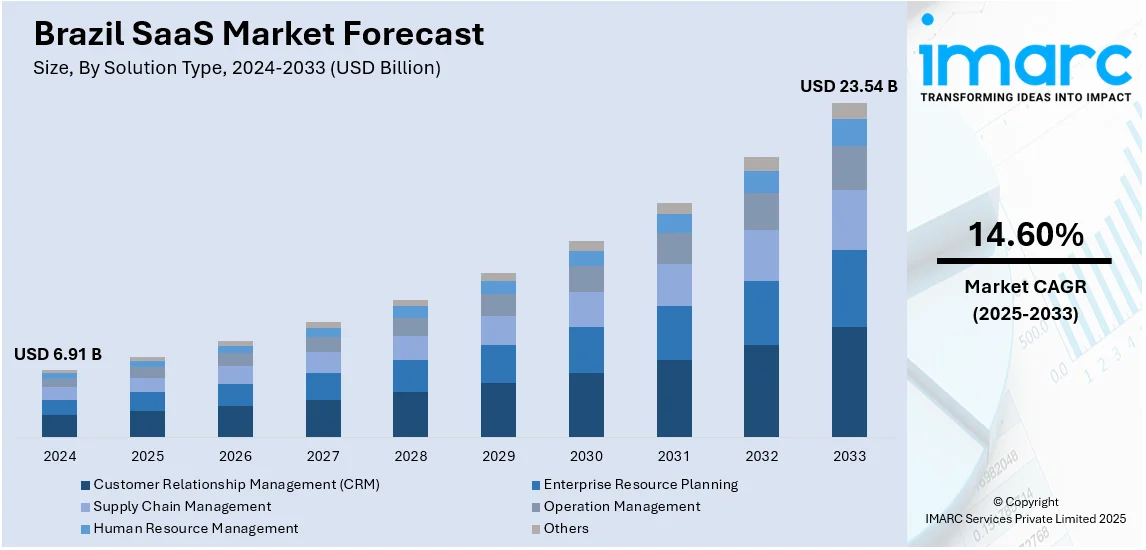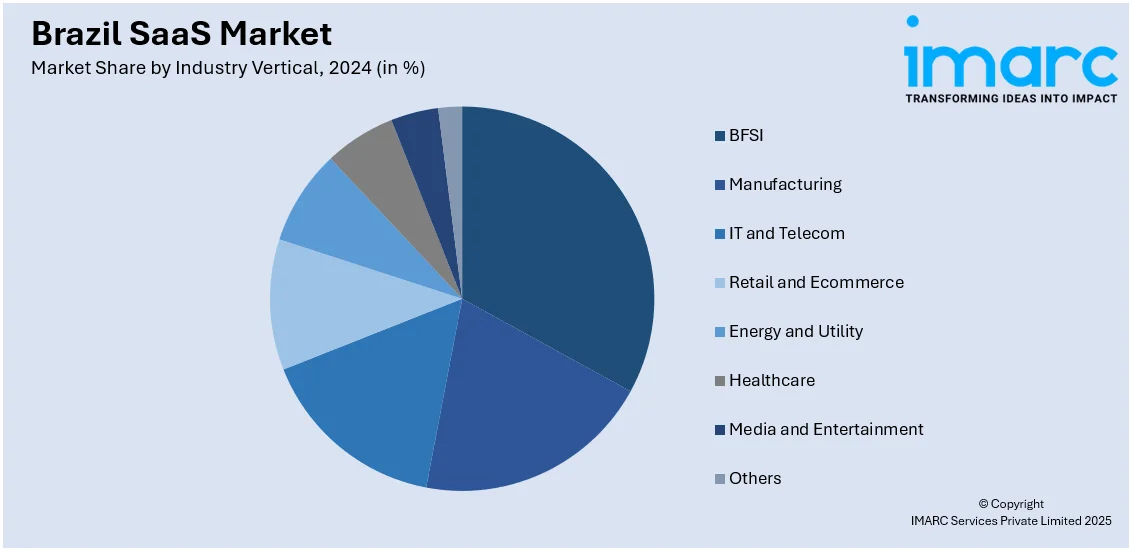
Brazil SaaS Market Size, Share, Trends and Forecast by Solution Type, Deployment Model, Organization Size, Industry Vertical, and Region, 2025-2033
Brazil SaaS Market Overview:
The Brazil SaaS market size reached USD 6.91 Billion in 2024. Looking forward, IMARC Group expects the market to reach USD 23.54 Billion by 2033, exhibiting a growth rate (CAGR) of 14.60% during 2025-2033. The market is experiencing growth due to the implementation of various government initiatives aimed at promoting digital inclusion, rapid expansion of a dynamic startup ecosystem, and substantial investments in cloud computing and artificial intelligence (AI) infrastructure, all of which are driving innovation, scalability, and technological advancements across industries.
|
Report Attribute
|
Key Statistics
|
|---|---|
|
Base Year
|
2024 |
|
Forecast Years
|
2025-2033
|
|
Historical Years
|
2019-2024
|
| Market Size in 2024 | USD 6.91 Billion |
| Market Forecast in 2033 | USD 23.54 Billion |
| Market Growth Rate (2025-2033) | 14.60% |
Brazil SaaS Market Trends:
Government Initiatives and Digital Infrastructure Development
The governing body is actively advancing digital transformation via initiatives that encourage cloud computing, adoption of software as a service (SaaS), and supporting the improvement of IT infrastructure. Initiatives and funding for 5G rollout are enhancing connectivity and broadening cloud access. Public sector entities are also moving to SaaS-based solutions to update administrative operations, boost data security, and enhance service provision. Policies promoting cloud adoption in businesses, along with tax benefits for technology investments, are additionally strengthening the market growth. Moreover, government-supported financing for innovation and technology startups is promoting the development of new SaaS companies. As digital infrastructure expands in both urban and rural areas, the adoption of SaaS is rapidly increasing in various industries, especially in underserved locales where cloud-based solutions offer affordable access to vital business resources. In 2023 , Brazil launched a BRL 28 billion Growth Acceleration Program (PAC) focused on enhancing digital inclusion and connectivity until 2026. The initiative focused on improving education and healthcare connectivity, expanding 4G and 5G infrastructure, and establishing digital information highways. It aimed to boost the local economy and attract private investments.

Growing Startup Ecosystem and Venture Capital Inflows
Brazil’s dynamic startup scene is driving the adoption of SaaS, especially in fintech, healthtech, and edtech. The nation boasts a robust entrepreneurial environment, with startup businesses utilizing SaaS models to provide innovative, scalable, and affordable solutions. Investments from venture capital in Brazilian startups have grown, as investors target SaaS companies for their strong growth potential and recurring revenue streams. For instance, in 2024, the Brazilian fintech Asaas obtained $148 Billion in Series C financing, led by Bond, SoftBank, and various other investors. The company, which provided financial software to SMEs, forecasted $72 Billion in revenue for that year. The investment indicates a revived interest in venture opportunities within Latin America's technology sector, especially in fintech. Furthermore, initiatives backed by the government, along with incubators and accelerators, are aiding SaaS startups, boosting competition and innovation in products. As digital payment usage rises and regulatory backing for FinTech’s grows, SaaS offerings in financial services are broadening, especially for small and medium enterprises (SMEs). The increasing need for data-oriented decision-making and automation is further propelling the advancement of AI-enabled SaaS solutions.
Expansion of Cloud and AI Infrastructure
Major technology firms are considerably boosting their spending on Brazil's cloud and AI infrastructure, speeding up the growth of the SaaS market. Increasing data center capacity boosts cloud accessibility, lowers latency, and strengthens cybersecurity, resulting in SaaS solutions that are more dependable and scalable for companies. These investments also bolster AI-powered SaaS applications, facilitating automation, predictive analytics, and enhanced machine learning features across various sectors. Improved infrastructure promotes innovation, encouraging local startups and businesses to utilize AI-driven SaaS solutions for optimizing operations. Moreover, training programs for the workforce in cloud computing and AI enhance the talent pool's skills, thereby boosting the adoption of SaaS. As international tech leaders enhance Brazil’s digital landscape, SaaS companies gain from superior cloud services, driving market growth and technological progress. In 2024 , Microsoft announced a $2.7 billion initiative to improve its cloud and AI infrastructure in Brazil within the next three years. The organization plans to enhance its data center operations in São Paulo, aiming to support Brazil's AI development and train 5 Billion people in AI skills.
Brazil SaaS Market Segmentation:
IMARC Group provides an analysis of the key trends in each segment of the market, along with forecasts at the regional level for 2025-2033. Our report has categorized the market based on solution type, deployment model, organization size, and industry vertical.
Solution Type Insights:
- Customer Relationship Management (CRM)
- Enterprise Resource Planning
- Supply Chain Management
- Operation Management
- Human Resource Management
- Others
The report has provided a detailed breakup and analysis of the market based on the solution type. This includes customer relationship management (CRM), enterprise resource planning, supply chain management, operation management, human resource management, and others.
Deployment Model Insights:
- Public
- Private
- Hybrid
A detailed breakup and analysis of the market based on the deployment model have also been provided in the report. This includes public, private, and hybrid.
Organization Size Insights:
- Small and Medium-sized Enterprises
- Large Enterprises
A detailed breakup and analysis of the market based on the organization size have also been provided in the report. This includes small and medium-sized enterprises and large enterprises.
Industry Vertical Insights:

- BFSI
- Manufacturing
- IT and Telecom
- Retail and Ecommerce
- Energy and Utility
- Healthcare
- Media and Entertainment
- Others
A detailed breakup and analysis of the market based on the industry vertical have also been provided in the report. This includes BFSI, manufacturing, IT and telecom, retail and ecommerce, energy and utility, healthcare, media and entertainment, and others.
Regional Insights:
- Southeast
- South
- Northeast
- North
- Central-West
The report has also provided a comprehensive analysis of all the major regional markets, which include Southeast, South, Northeast, North, and Central-West.
Competitive Landscape:
The market research report has also provided a comprehensive analysis of the competitive landscape. Competitive analysis such as market structure, key player positioning, top winning strategies, competitive dashboard, and company evaluation quadrant has been covered in the report. Also, detailed profiles of all major companies have been provided.
Brazil SaaS Market News:
- In August 2024, BemAgro, a Brazil-based SaaS startup offers artificial intelligence (AI)-based solutions in agriculture announced a raise of $2.6 Billion in a pre-Series A funding round. This investment came from CNH Industrial, Suzano Ventures, and ATVOS. The company said that they will use the new funds to accelerate the development of its AI-driven platform, which optimizes crop and forest management through advanced data processing from tractors, drones, and other sources.
- In June 2024, Amagi, a cloud-based SaaS technology for broadcast and connected TV (CTV), announced that they have forged a strategic partnership with Brazil's Globo, one of the world's largest media groups. As per the partnership, Globo’s six free ad-supported television (FAST) channels were implemented into the Amagi cloud-based playout platform.
Brazil SaaS Market Report Coverage:
| Report Features | Details |
|---|---|
| Base Year of the Analysis | 2024 |
| Historical Period | 2019-2024 |
| Forecast Period | 2025-2033 |
| Units | Billion USD |
| Scope of the Report |
Exploration of Historical Trends and Market Outlook, Industry Catalysts and Challenges, Segment-Wise Historical and Future Market Assessment:
|
| Solution Types Covered | Customer Relationship Management (CRM), Enterprise Resource Planning, Supply Chain Management, Operation Management, Human Resource Management, Others |
| Deployment Models Covered | Public, Private, Hybrid |
| Organization Sizes Covered | Small and Medium-sized Enterprises, Large Enterprises. |
| Industry Verticals Covered | BFSI, Manufacturing, IT and Telecom, Retail and Ecommerce, Energy and Utility, Healthcare, Media and Entertainment, Others |
| Regions Covered | Southeast, South, Northeast, North, Central-West |
| Customization Scope | 10% Free Customization |
| Post-Sale Analyst Support | 10-12 Weeks |
| Delivery Format | PDF and Excel through Email (We can also provide the editable version of the report in PPT/Word format on special request) |
Key Questions Answered in This Report:
- How has the Brazil SaaS market performed so far and how will it perform in the coming years?
- What is the breakup of the Brazil SaaS market on the basis of solution type?
- What is the breakup of the Brazil SaaS market on the basis of deployment model?
- What is the breakup of the Brazil SaaS market on the basis of organization size?
- What is the breakup of the Brazil SaaS market on the basis of industry vertical?
- What is the breakup of the Brazil SaaS market on the basis of region?
- What are the various stages in the value chain of the Brazil SaaS market?
- What are the key driving factors and challenges in the Brazil SaaS market?
- What is the structure of the Brazil SaaS market and who are the key players?
- What is the degree of competition in the Brazil SaaS market?
Key Benefits for Stakeholders:
- IMARC’s industry report offers a comprehensive quantitative analysis of various market segments, historical and current market trends, market forecasts, and dynamics of the Brazil SaaS market from 2019-2033.
- The research report provides the latest information on the market drivers, challenges, and opportunities in the Brazil SaaS market.
- Porter's five forces analysis assist stakeholders in assessing the impact of new entrants, competitive rivalry, supplier power, buyer power, and the threat of substitution. It helps stakeholders to analyze the level of competition within the Brazil SaaS industry and its attractiveness.
- Competitive landscape allows stakeholders to understand their competitive environment and provides an insight into the current positions of key players in the market.
Need more help?
- Speak to our experienced analysts for insights on the current market scenarios.
- Include additional segments and countries to customize the report as per your requirement.
- Gain an unparalleled competitive advantage in your domain by understanding how to utilize the report and positively impacting your operations and revenue.
- For further assistance, please connect with our analysts.
 Inquire Before Buying
Inquire Before Buying
 Speak to an Analyst
Speak to an Analyst
 Request Brochure
Request Brochure
 Request Customization
Request Customization




.webp)




.webp)












